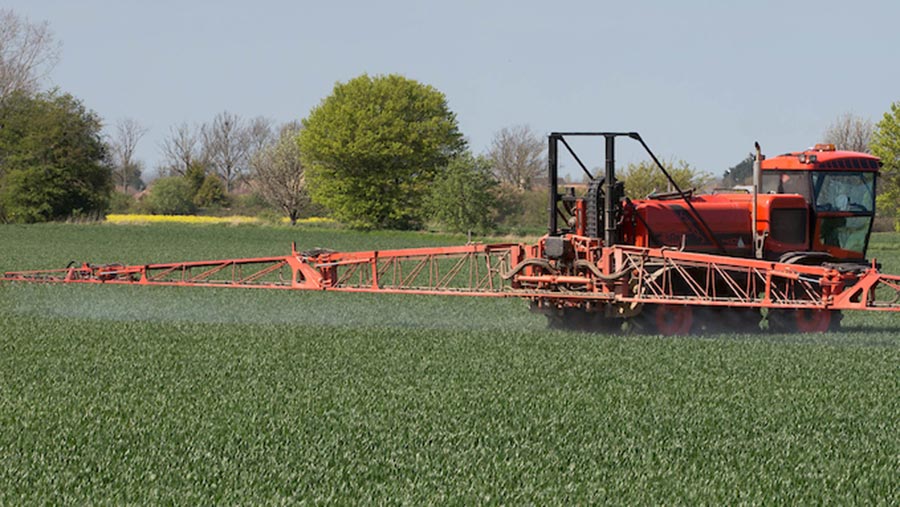Crop Watch: Stressed barley and drought concerns
 © Tim Scrivener
© Tim Scrivener Concerns are growing about the continued lack of rain, especially for spring crops in the East. With dry conditions in mind, some of our agronomists are tweaking their agronomy inputs, such as growth regulation.
Winter barley crops have been suffering from the cooler conditions prior to Easter and are showing signs of stress with spotting.
And while disease risk is currently low, unlike this time last year, there is more disease around in crops. So given the right conditions, sclerotinia in OSR and septoria and rusts in wheat, could still strike.
East: Marion Self
AICC/Prime Agriculture (Suffolk)

Marion Self
Temperatures are rising and the sunshine has returned, but growers are concerned as dry conditions continue with no significant rain forecast.
All crops would welcome rain, but it is the spring cropping that needs it soon.
Spring seed-beds are reasonable with moisture around the seed, but as conditions continue to dry, establishment is slow and sometimes uneven.
See also: How to grow septoria-resistant wheat in the West
Dry conditions focus our minds on the level of agronomic input and returns on investment. Winter crops still look well and we remain focused on achieving the crop’s full potential.
We are mindful that applications should be appropriate for the weather we’re going to get, as well as what has been.
With no rain in the immediate forecast, plant growth regulator programmes are being adapted towards the prevailing dry conditions.
Final nitrogen applications for yield are being completed on winter and spring crops just leaving later top-ups on quality wheats.
In wheat, septoria infection reflects the Recommended List rating with differences between varieties.
Monitor susceptible varieties for yellow rust and mildew as diseases will develop quickly in milder conditions, especially in untreated later drilled and stressed crops.
Most wheats have received a T1 application (at leaf 3 emergence) around Easter. Now we are look towards T2 sprays at flag leaf emergence, about three weeks later.
If this three-week gap is likely to be stretched, for example in early drilled wheats, or due to cool conditions, we may have to consider a T1.5 spray.
However, the necessity of this spray will depend on varietal susceptibility to rust and septoria, closeness of flag leaf emergence and weather.
These sprays will be limited and where appropriate fungicide will be drawn from the planned T2.
Winter barley will receive a late season growth regulator with chlorothalonil applications during late stem extension (before boots split). Check labels of individual products for the latest application timing.
Spring barley is approaching the T1 fungicide timing (early stem extension). This mix will include robust doses of herbicide for broad-leaved weed control in dry conditions.
The British Beet Research Organisation’s aphid monitoring is underway and will give early warning of aphid activity. However, we still need to monitor aphid thresholds in our own crops.
The emergency authorisation for Biscaya (thiacloprid) is now active so if required, we have an allowance of two applications of Biscaya and one of Tepeki (flonicamid).
West: Antony Wade
Hillhampton Technical Services (Herefordshire/Shropshire)

Antony Wade
The sunny and warm Easter weekend followed a fortnight of below-average temperatures and we had the absurd occurrence on 4 April with oilseed rape in early flower, but heavy snow falling.
Luckily it only lasted for a couple of hours and didn’t cause any lasting damage.
Due to the recent cool weather, the sclerotinia risk has been low, but the hot Easter spell followed by the forecasted showers will create conditions conducive to infection.
Those who have witnessed the devastating effect this disease can have on promising crops, and how little moisture is needed for this to happen, will understand why protection is worthwhile.
Therefore, a cost-effective protectant fungicide based on Boscalid for sclerotinia with azoxystrobin for green area prolongation will be applied by the time this is published.
Winter barley crops have been extremely challenging to manage and have not liked the cooler conditions.
The latest proliferation of spotting has meant significant time with the hand lens, trying to identify whether it’s due to manganese deficiency, early ramularia infection or net blotch.
But there is no conclusive evidence of any of these, so cold stress has been the conclusion.
Winter wheat has been the main focus for field walking to check on eventual leaf 3 emergence.
I expect following the warmth over recent days, that by the time this article is published, most of the September sowings will have leaf 3 fully merged.
I can understand those that have had minimal rainfall in the last two months considering cutting back on T1 fungicide inputs.
We have been lucky to have had 87mm in the first 10 days of April which many would have liked, so as a result, I am not cutting back on my T1 which will include an SDHI.
Eyespot can be found on the many varieties with ratings of 4 or less.
Septoria is plentiful on leaves 5 and 6 plus the rainfall we had earlier in the month followed by cooler temperatures, there is no doubt that we will have latent infection yet to show visible symptoms on leaf 4 and leaf 3 tips.
North: Mary Munro
AICC/Strutt and Parker (Perthshire)

Mary Munro
Most parts of Scotland have been basking in the recent warm sun. The temperature jumped from 8C to 23C in one day and the result was a massive hatch of pollen beetles.
I have never seen such large numbers in OSR plants – trying to count them is difficult when you have about 50 in your hand.
I am always loathed to use insecticides on crops if I can avoid it, and these numbers were well above any threshold, but in plants at the edge of a field.
I prefer to get further into the crop to make an assessment, and also consider the owner’s preference.
Several growers are keen beekeepers, and there are a growing number who are trying to limit pesticide use in general. So not all crops will be sprayed.
Interestingly, pollen beetles rarely reach threshold levels at the green-yellow bud stage here, pollen beetle activity is normally later and the potential for damage much less.
The spraying jobs are queuing up. The early-sown spring barleys are getting herbicide plus manganese, wheats are approaching T1 (jumping fast from tillering to growth stage 31) and winter barley is doing its usual trick of going from an inert over-wintered state to first node in no time at all.
The spring weed tidy-up is focusing on cleavers and bromes, and the choice of broad-leaf product really depends what else is there. Fumitory and groundsel can be persistent offenders.
Annual meadow grass is hard to knock out at this stage and the effective products can be hard on the crop, so it is better dealt with pre-emergence, but where necessary the likes of Othello (diflufenican + iodosulfuron + mesosulfuron) can do a great job in wheat.
There is more disease around than last year, despite this very dry spell, and good septoria control at T1 will be essential.
As ever some varieties are worse than others, but everything will get a good SDHI at a decent rate to keep it under control.
I have seen some yellow rust in East Lothian and there is also active mildew in some places. Ideally, we could do with rain now just to keep everything moving forwards.
South: Richard Harding
Procam (Sussex)

Richard Harding
Continued dry weather and bright sunshine with cooler nights, has resulted in crop development progressing at a more “normal” pace, compared with last spring.
The lack of significant rain is worrying and tramlines cracking before mid-April are not welcome quite this early in the season.
On the more forward winter wheat, T1 fungicides are now being applied with a mix of epoxiconazole, isopyrazam and chlorothalonil.
Generally, leaf 3 emergence has slowed considerably in most cases. The disease risk remains relatively low with very little septoria visibly present although brown rust is easily found in winter barley.
The high daily temperature ranges interspersed with periods of high light intensity are causing some severe stress or abiotic lesions in winter barley crops as they rapidly move through their growth stages.
Mildew can be easily found in the base of some of the thicker crops or in valley bottoms.
Oilseed rape is moving into full flower with some of the more forward crops at or around the “mid-flowering” timing.
With the recent pattern of weather, the sclerotinia risk remains generally low – but this can change rapidly and increase as temperatures remain high and with rain now forecast.
A mix of fluopyram and prothioconazole applied as a protectant spray on high risk crops ahead of a major infection is planned.
Where an earlier spray is made in anticipation of the flowering period being extended, then a second fungicide may be required to protect the crop if conditions are still high risk.
This is particularly likely to be the case where cabbage stem flea beetle or winter stem weevil damage has caused a wide range of plant development.
Seed weevil numbers were at low levels last week although threshold levels are now being reached in some crops as temperatures remain high and we lose the chance of night frosts.
The threshold to justify insecticide treatment against seed weevil is more than one weevil/plant in the South.
Where sprays are justified, they are likely to be applied during flowering, but ideally by petal fall before too many eggs are laid.
Tip of the week
Monitor susceptible varieties for yellow rust and mildew as diseases will develop quickly in milder conditions especially in untreated later-drilled and stressed crops.
Marion Self

